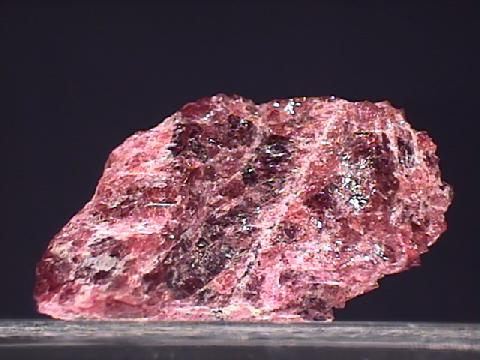
EUDIALYTE
Specimen eud-3
$ 45.00
Dims: 1.5 x 0.9 x 0.8" (3.8 x 2.3 x 2.0 cm)
Wt: 15.7 g
Kipawa Syenite Gneiss Complex, W. Quebec, Canada
This thumbnail specimen consists of an amorpous chunk of crystalline Eudilyte. It shows no definable crystal form and is generally rough and uneven on all surfaces. Its color is deep red with a violet tinge, and its luster is pearly to vitreous. The material is moderately to dimly translucent due to intense internal fracturing, and is translucent in small areas. Only a thin crust of a dark host rock is set into one surface.
 Amethyst Galleries' Mineral Gallery MINERALS |

EUDIALYTE specimen eud-1
$ 60.00
$ 60.00
Dims: 3.3" x 2.2" x 2.1" (8.4 x 5.6 x 5.3 cm)
Wt: 6.42 oz. (182.0 g)
Sheffield Lake, Quebec, Canada
Though broken and heavily internally fractured, this specimen is quite attractive, and rather unusual. It consists of a large fragment of a Eudialyte crystal that is resting on a base made up of what appears to be a variety of feldspar, and a small amount of crystalline anhydrite. The Eudialyte has a deep red color with a hint of violet, a vitreous luster, and is transparent with small spots of clarity between the internal fractures. The material that I believe is anhydrite has the standard pale blue color, columnar habit, and basal parting that is evident in most specimens that I have seen. The feldspar material is hard (5-6), and has clean and definite cleavage in 2 directions. It is colorless and has a vitreous to pearly luster. I am relatively certain about my hypotheses, but I want to make certain, and will write more when I do. Nonetheless, it is a very attractive specimen of a mineral that I don't see often.


eud-1 ($ 60.00)
Sheffield Lake, Quebec, Canada
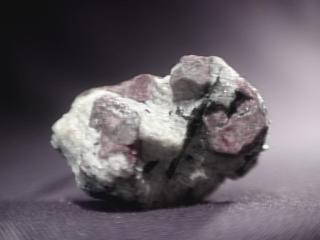
$ 190.00
Dims: 1.8" x 1.2" x 1.0" (4.6 x 3.0 x 2.5 cm)
Wt: 1.41 oz. (40.0 g)
Mount Eveslogehorr, Khibiny Massif, Murmansk Oblast, Kola Peninsula, Russia
This small hand specimen is the most impressive Eudialyte piece that I have yet seen! It consists of a chunk of nepheline-bearing pegmatite in which rest four crystals, three of which show only a small amount of damage and are essentially complete. They have a distorted rhombohedral form that reminds me of orthoclase crystals. Their edges, though rounded, are still quite evident, and their faces are relatively flat and have a waxy-to-pearly luster. Their color is a moderate red with a hint of violet, and they appear to be completely opaque, though this may be mostly due to their intense internal fracturing. The most incomplete crystal shows a very uneven breakage surface. There are some thin, black needlelike crystals among the Eudialytes, but I do not know exactly what they are. From what I have heard, crystals of this mineral are rather difficult to find.
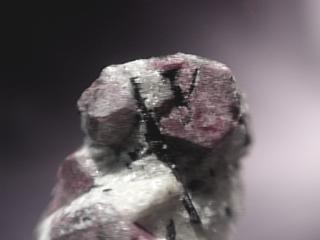

Mount Eveslogehorr, Khibiny Massif, Murmansk Oblast, Kola Peninsula, Russia

EUDIALYTE specimen eud-3
$ 45.00
$ 45.00
Dims: 1.5 x 0.9 x 0.8" (3.8 x 2.3 x 2.0 cm)
Wt: 15.7 g
Kipawa Syenite Gneiss Complex, W. Quebec, Canada
This thumbnail specimen consists of an amorpous chunk of crystalline Eudilyte. It shows no definable crystal form and is generally rough and uneven on all surfaces. Its color is deep red with a violet tinge, and its luster is pearly to vitreous. The material is moderately to dimly translucent due to intense internal fracturing, and is translucent in small areas. Only a thin crust of a dark host rock is set into one surface.

eud-3 ($ 45.00)
Kipawa Syenite Gneiss Complex, W. Quebec, Canada
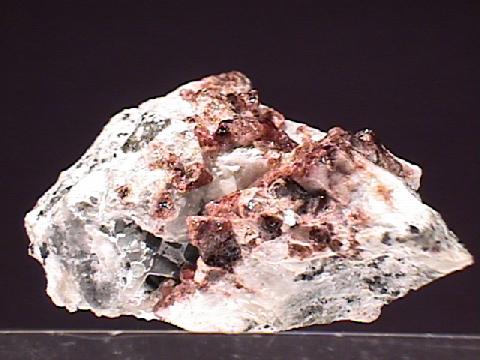
EUDIALYTE specimen eud-4
$ 98.00
$ 98.00
Dims: 2.3 x 1.4 x 1.3" (5.8 x 3.6 x 3.3 cm)
Wt: 1.77 oz. (50.2 g)
Mount Saint Hilaire, Quebec, Canada
Several definite Eudialyte crystals rest on the dappled white host rock of this large thumbnail specimen. These crystals are quite small, not exceeding 0.3" (8 mm) along any axis, and most appear to be damaged or even broken. Those that are intact, however, have excellent trigonal prismatic form with triangular cross-sections (one or two appear to have hexagonal cross-sections). Their edges are generally well-defined, and their faces are clean and possess a vitreous luster. All have a deep wine-red coloration with a hint of brown that resembles that of many garnets. Most are at least dimly translucent, and a few are likely partly transparent. The Eudialytes line a hollow in the host rock, and are accompanied by a white mineral that appears to have a pseudohexagonal form- I cannot identify it, however. The rock in which they rest strongly resembles a syenite, but I cannot define it exactly.

eud-4 ($ 98.00)
Mount Saint Hilaire, Quebec, Canada
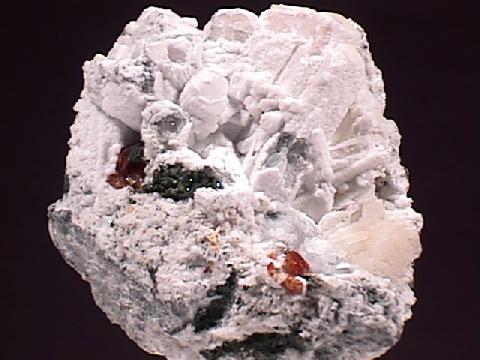
EUDIALYTE specimen eud-5
$ 45.00
$ 45.00
Dims: 1.5 x 1.4 x 1.0" (3.8 x 3.6 x 2.5 cm)
Wt: 1.28 oz. (36.4 g)
Mount Saint Hilaire, Quebec, Canada
This thumbnail specimen contains a few very small Eudialyte cystals. These crystals do not exceed 0.1" (3 mm) in diameter and appear to be in reasonably good condition- only one of them is visibly damaged. Though they their size and intergrowth makes study difficult, they appear to have good trigonal prismatic form, with well-defined edges and clean faces that have a vitreous luster. Their color is their most noticeable trait- it is a deep red with a hint of orange, reminding me of many garnets that I have seen. The Eudialytes are accompanied by several natrolite crystals of impressive size (up to 0.5" or 1.3 cm in length). Almost all of the natrolites are damaged, and several are broken. However, this breakage allows us to see that the natrolite crystals contain a colorless, transparent "core", which is surrounded by a bright white, opaque "shell". Only a small amount of a dark green host rock is present.

eud-5 ($ 45.00)
Mount Saint Hilaire, Quebec, Canada
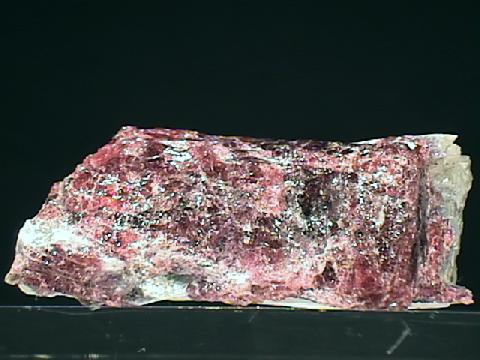
EUDIALYTE specimen eud-6
$ 30.00
$ 30.00
Dims: 1.9 x 0.8 x 0.7" (4.8 x 2.0 x 1.8 cm)
Wt: 1.00 oz. (28.4 g)
Kipawa Syenite Gneiss Complex, western Quebec, Canada
This specimen consists of a shapeless chunk of crystalline Eudialyte that is attached to a piece of compact, fibrous agrellite. The Eudialyte is heavily broken- no evidence of crystal form is present- and all edges and surfaces are rough and uneven. The material has the classic deep red-violet color of its species and a bright pearly-to-vitreous luster. The agrellite, a sodium calcium silicate fluoride, has a pale, gray-white color and a rather silky luster due to its fibrous habit.

eud-6 ($ 30.00)
Kipawa Syenite Gneiss Complex, western Quebec, Canada
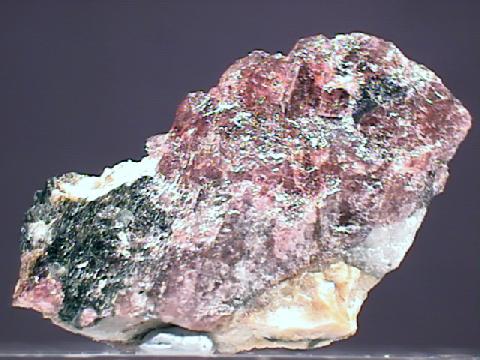
EUDIALYTE specimen eud-7
$ 20.00
$ 20.00
Dims: 1.2 x 0.6 x 0.2" (3.0 x 1.5 x 0.5 cm)
Wt: 12.8 g w/ specimen box
Khibine, Kola Peninsula, Russia
A chunk of semicrystalline Eudialyte makes up the bulk of this thumbnail specimen. Though a few crystalline tendencies are notable, no definite crystal form is evident. The Eudialyte has the classic deep red color with a hint of violet and a pearly-to-vitreous luster, and is translucent. A small amount of what appears to be a feldspar host rock is present, and the piece is affixed inside a plastic specimen box with an adhesive putty.

eud-7 ($ 20.00)
Khibine, Kola Peninsula, Russia
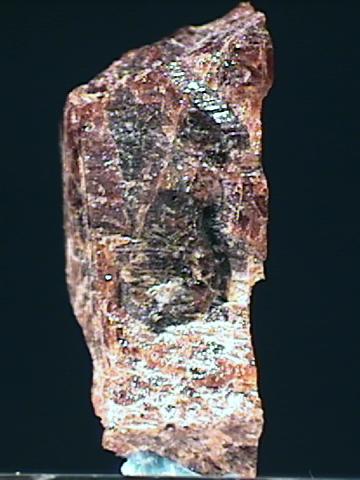
EUDIALYTE specimen eud-8
$ 25.00
$ 25.00
Dims: 0.9 x 0.5 x 0.4" (2.3 x 1.3 x 1.0 cm)
Wt: 12.9 g w/ specimen box
Khibine, Kola Peninsula, Russia
This thumbnail specimen consists of a shapeless chunk of crystalline Eudialyte. The piece shows no evidence of a definite crystal form- all faces and edges are uneven and exist due to breakage. It has a deep red-brown coloration and a pearly luster, and is only dimly translucent, though a few spots show noticeable transparence. There is no host rock of any sort present, and it is affixed inside a plastic specimen box with an adhesive putty.

eud-8 ($ 25.00)
Khibine, Kola Peninsula, Russia
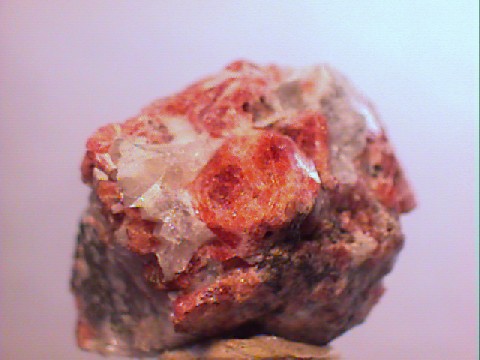
EUDIALYTE specimen eud-9
$ 25.00
$ 25.00
Dims: 1.2 x 1.0 x 0.8" (3.0 x 2.4 x 2.1 cm)
Wt: 17 g
not yet determined
This thumbnail piece shows some of the most well-formed Eudialyte crystals that I have seen. These crystals do not exceed 0.3" (8 mm) in diameter and are generally in good condition. Where undamaged, their trigonal, thick tabular form is excellent, showing well-defined edges and clean faces that possess a pearly-to-vitreous luster. All have a pink, rusty coloration and are only dimly translucent, if at all. They are embedded in the standard pegmatite matrix, and the piece is affixed inside a plastic specimen box with a removable putty.

eud-9 ($ 25.00)
not yet determined

EUDIALYTE specimen eud-10
$ 30.00
$ 30.00
Dims: 1.5 x 1.1 x 0.9" (3.7 x 2.9 x 2.2 cm)
Wt: 22 g
Kipawa Syenite Gneiss Complex, Quebec, Canada
This thumbnail piece appears to be made up mostly of Eudialyte by weight. Though the material is crystalline in nature, no complete crystals are present. The only evidence of crystal form is a single flat face on one end of the piece- all other surfaces are uneven. The Eudialyte has the standard red color with a hint of violet and a dull pearly luster on its one intact face (the broken surfaces are vitreous). Though it is essentially transparent, the material is extremely internally fractured. Collected in 1993 for the Geological Survey of Canada, documentation shows that this piece likely also contains agrellite, vlasovite and mosandrite.

eud-10 ($ 30.00)
Kipawa Syenite Gneiss Complex, Quebec, Canada
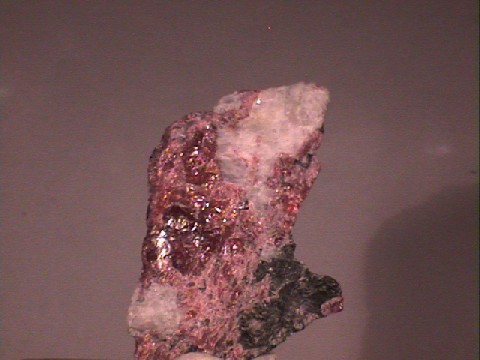
EUDIALYTE specimen eud-11
$ 25.00
$ 25.00
Dims: 2/3 x 1.4 x 0.8" (5.7 x 3.6 x 2.0 cm)
Wt: 1.2 oz. (33 g)
Kipawa Syenite Gneiss Complex, Western Quebec, Canada
A considerable amount of rough, shapeless Eudialyte makes up this hand specimen. It shows no crystal form whatsoever, and so is either massive or so broken that not a face or edge is left. It has the standard deep red-violet coloration and vitreous luster, and is transparent and dimly to moderately clear, having rather intense internal fracturing. It is embedded in a piece of syenite matrix.

eud-11 ($ 25.00)
Kipawa Syenite Gneiss Complex, Western Quebec, Canada
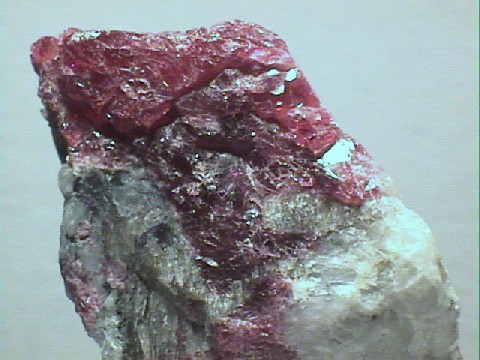
EUDIALYTE specimen eud-12
$ 30.00
$ 30.00
Dims: 2.0 x 1.2 x 1.1" (5.2 x 3.0 x 2.7 cm)
Wt: 1.5 oz. (43 g)
Kipawa Syenite Gneiss Complex, Western Quebec, Canada
This hand specimen consists of a syenite base rock to which is attached a few different bits of rough, amorphous Eudialyte. This material shows no evidence of crystal form and has both rough and conchoidal surface textures. It has the classic deep red-violet coloration and vitreous luster, and is transparent but heavily internally fractured.

eud-12 ($ 30.00)
Kipawa Syenite Gneiss Complex, Western Quebec, Canada
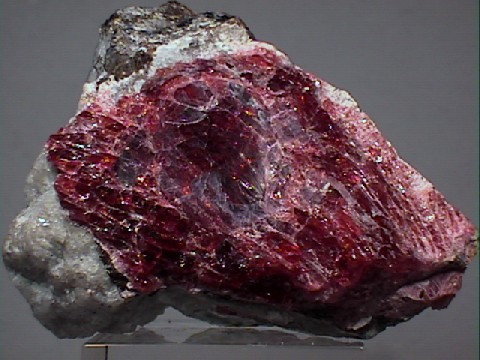
EUDIALYTE specimen eud-13
$ 105.00
$ 105.00
Dims:2.7x2.0x1.9" (6.9x5.1x4.8 cm)
Wt: 5.5oz. (156g)
Kipawa, Quebec, canada
This specimen consists of a crystalline mass of eudialyte in unidentified matrix material. The eudialyte is nearly transparent, much more so than many other specimens I have seen. The crystal shows much internal shattering. Nothing can be determined of eudialyte's hexagonal form from this specimen, however, it does show good vitreous luster.
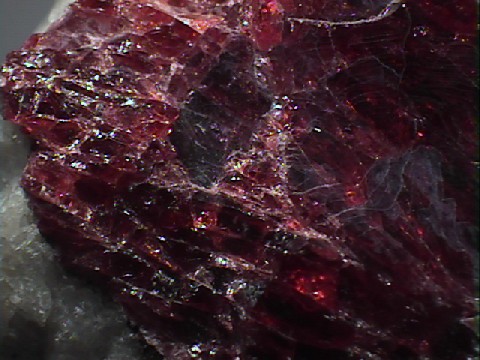

eud-13 ($105.00)
Kipawa, Quebec, canada
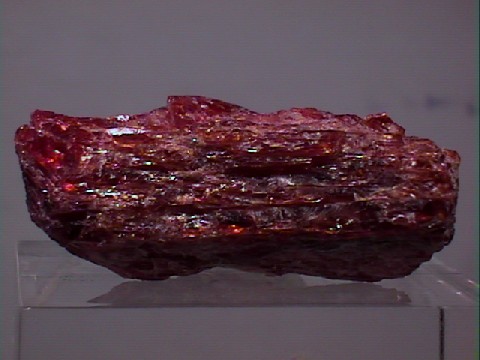
EUDIALYTE specimen eud-14
$ 25.00
$ 25.00
Dims:1.5x0.7x0.6" (3.8x1.8x1.5 cm)
Wt: 0.5oz. (14g)
Kipawa Syenite Gneiss Complex, Quebec, Canada
This specimen consists of a single crystal fragment of eudialyte, with no matrix present. The crystal is reddish-brown in color and translucent on the edges. The crystal is not terminated, and shows the internal shattering that seems to be the norm for this local.

eud-14 ($ 25.00)
Kipawa Syenite Gneiss Complex, Quebec, Canada
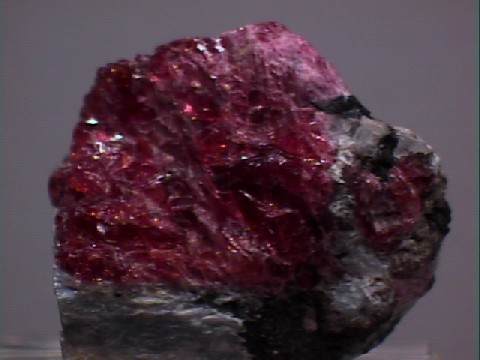
EUDIALYTE specimen eud-15
$ 32.00
$ 32.00
Dims:1.2x1.1x0.9" (3.0x2.8x2.3 cm)
Wt: 0.6oz. (18g)
Kipawa Syenite Gneiss Complex, Quebec, Canada
The matrix rock of this specimen is host to a crystalline mass of eudialyte. The eudialyte is an aesthetic reddish-brown in color, and shows a high level of translucence. It is internally shattered, as is common for this mineral/location. This specimen was part of a larger crystal; this shattered base is all that remains.

eud-15 ($ 32.00)
Kipawa Syenite Gneiss Complex, Quebec, Canada
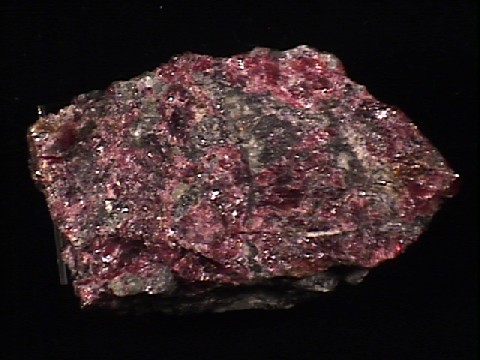
EUDIALYTE specimen eud-16
$ 25.00
$ 25.00
Dims: 2.6x1.8x1.4" (6.4x4.5x3.6cm)
Wt: 3.53 oz. (100.0g)
Khibiny, Kola, Russia
The burgandy of the eudialite contrasts nicely with the unidentified green and black minerals of the host rock. The eudialite is transparent but only a few crystals have natural prismatic surfaces - most of it is fracture or cleavage.

eud-16 ($ 25.00)
Khibiny, Kola, Russia
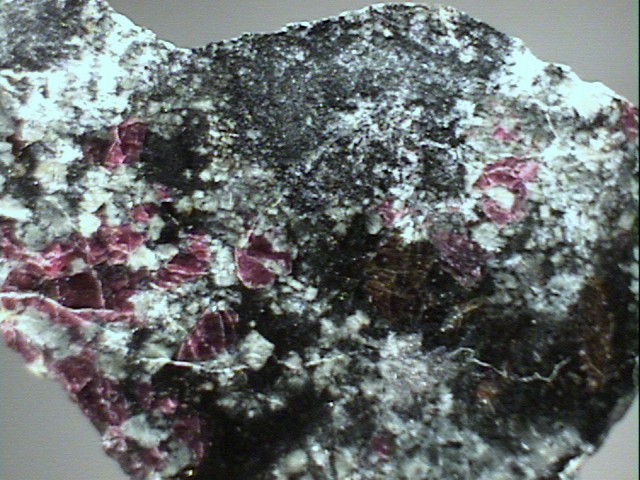
EUDIALYTE specimen eud-17
$ 40.00
$ 40.00
Dims: 5.33x3.59x1.02" (13.53x9.13x2.58cm)
Wt: 11.52oz (326g)
Khibiny Massif, Kola Peninsula, Russia
This is a very interesting specimen. It has been polished on one side, And all surfaces of the specimen exhibit multiple crystals of deep maroon colored eudialite crystals. These are embedded in a complex matrix consisting of several unidentified minerals. Some are white and some appear black, but a loupe reveals that the black crystals are really masses of find dark green acicular crystals which partly penetrate into the white minerals, giving them a tint of green. There are also several crystals of astrophyllite with an excellent brown color and golden fire.

eud-17 ($ 40.00)
Khibiny Massif, Kola Peninsula, Russia
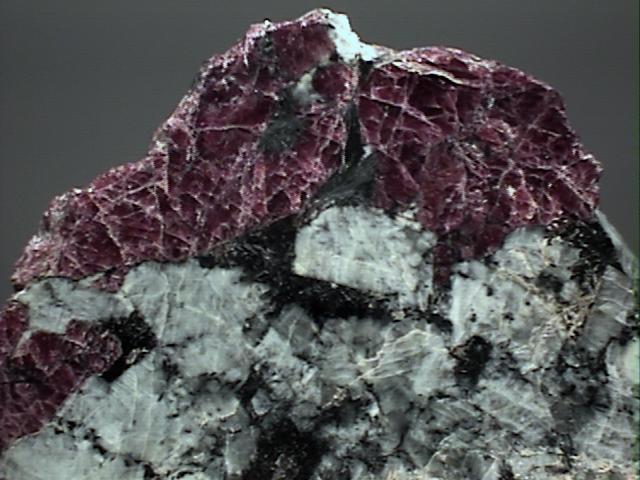
EUDIALYTE specimen eud-18
$ 25.00
$ 25.00
Dims: 2.89x1.88x0.98" (7.34x4.76x2.48cm)
Wt: 3.87oz (109.6h)
Khibiny Massif, Kola Peninsula, Russia
This specimen is perhaps 25% eudialyte, and the specimen has been cut flat on its base and one face, which has been polished to a high luster. The eudialyte is a deep maroon color, and is translucent, even transparent in some areas. The host rock contains multiple minerals. It has many acicular black crystals, some of which are in radial clusters. I am thinking that they are aegirine, although I cannot be certain. Another mineral is translucent white with right-angle cleavage fractures and this is likely one of the plagioclase feldspars, as there appears to be a patch of quartz which would make the presence of nepheline unlikely.
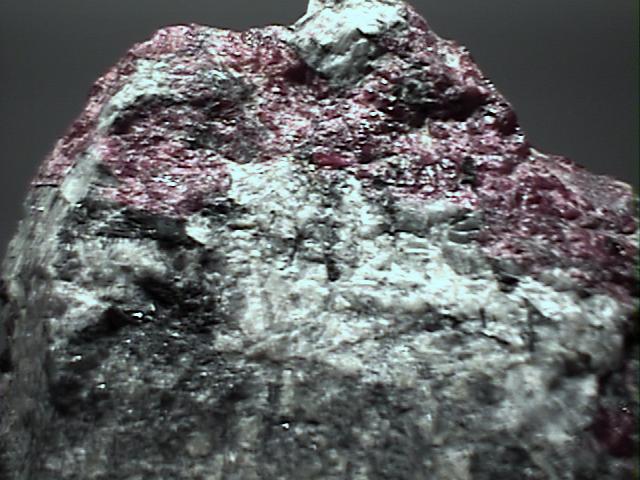

eud-18 ($ 25.00)
Khibiny Massif, Kola Peninsula, Russia